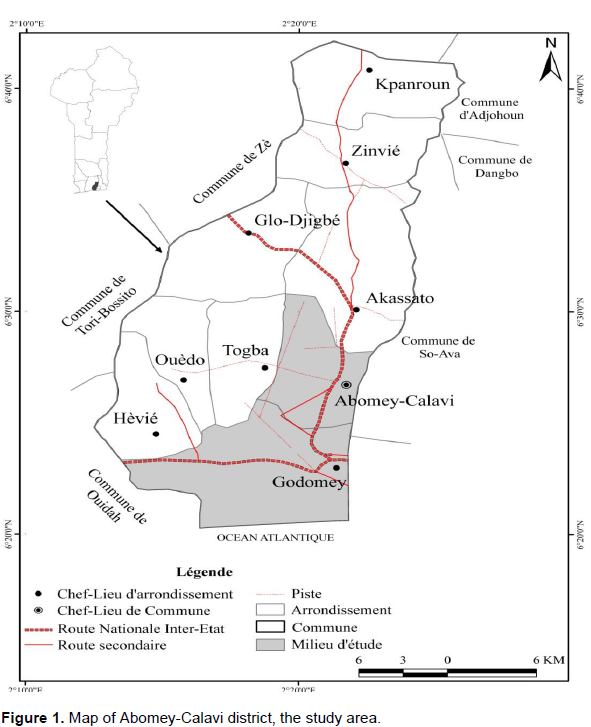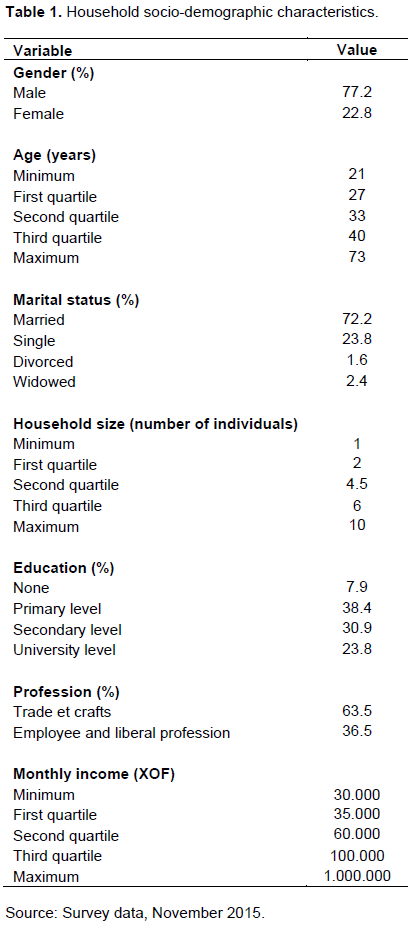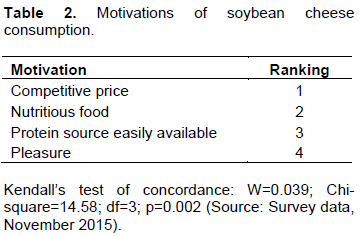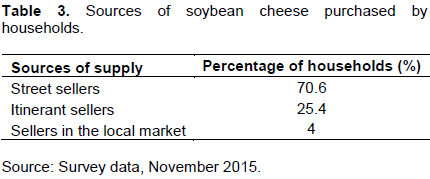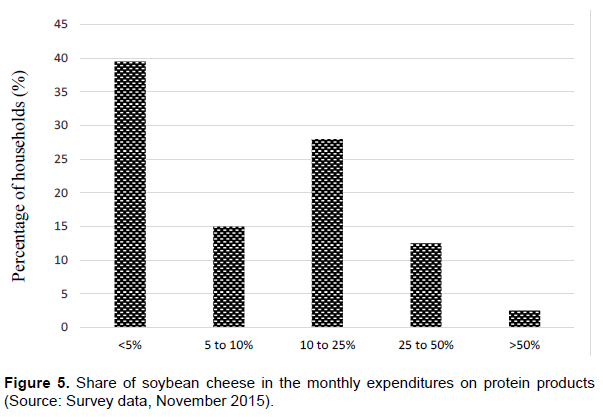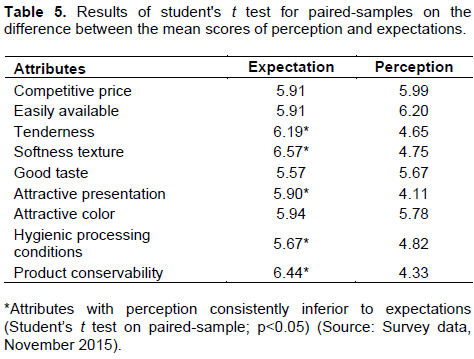ABSTRACT
The inability of processing enterprises in Sub-Saharan Africa to supply products to meet consumer needs hampers the potential of agricultural value chains. This study analyzed the consumption of soybean cheese in Abomey-Calavi (Southern Benin), in order to identify opportunities of valorizing this commodity. A survey was conducted in November 2015 among 126 households in two main sub-districts. The data on socio-demographic characteristics, soybean cheese consumption motivations and patterns, and consumers’ expectations and perceptions were collected based on structured interviews. Data processing includes the assessment of consumers’ motivations based on Kendall’s test of concordance, and unsatisfied expectations were identified by assessing the significance of the difference between expectations and the perception of the consumers. Competitive price was the most important purchasing motivation for the soybean cheese consumers. Consumers were not satisfied with the following attributes: soft texture, tenderness, attractive presentation, hygienic processing conditions, and long shelf life. The training of processors on hygiene rules, the promotion of the certification under a collective label, the improvement of soybean cheese marketing, and the settlement of an innovation platform to identify upgrading needs could boost the soybean cheese value chain in Southern Benin.
Key words: Market access, women entrepreneurship, consumer expectations, soybean cheese, Benin.
Market-oriented agriculture is viewed as a strategy to address the challenges of unemployment, poverty and food insecurity in Sub-Saharan Africa (Le Courtois et al., 2011; Shiferaw et al., 2011; Fischer and Qaim, 2012; Amos et al., 2014).
Market access strategies include improving the performance of small-scale processing enterprises, improving product quality, and promoting entrepreneur-
ship and agribusiness (Yumkella et al., 2011; Broutin et al., 2014). The agricultural processing contributes to economic growth, transformation of rural areas, job creation, and food security (Vorley and Lançon, 2016).
The agri-food sector can take advantage of fast urbanization in Africa which will result in increased demand for processed products (Jayne et al., 2013).
While urban demand for processed food is rising, local processors are partially able to capture these opportunities (Jayne et al., 2013). To help producers and other value chain stakeholders to take advantage of urban food demand, it is important to provide them with sound information about urban consumers and their needs.
The objective of this study is to analyze soybean cheese consumption in order to take advantage of the potential of this product in development strategies in Southern Benin. Indeed, soybean cheese offers opportunity to address several challenges: food security (protein supply for the population), tackling poverty through market access, and the promotion of women entrepreneurship. Soybean cheese production is one of the main activities of women in the Atlantique department (Southern Benin) (Dedjelenou, 2014). However, the possibility for processors and other value chain stakeholders to improve their income depends on their ability to deliver products that meet consumers’ expectations (Fold and Gough, 2008).
This study was built on an integrated framework combining the consumer profile (Kilchling et al., 2009; Aoudji et al., 2011), their motivations (Ragaert et al., 2004; Close and Kukar-Kinney, 2010), consumption patterns (Verbeke and Vackier, 2004; Santosa and Guinard, 2011) and the expectancy disconfirmation paradigm (Oliver, 1980; Taylor, 1997).
This paradigm is based on two concepts: expectations and perception. Expectations are product attributes sought by consumers when purchasing (Becker et al., 2000; Glitsch, 2000), while perception is the consumer evaluation of the product based on these attributes (Kelley and Turley, 2001). The level of satisfaction depends on the discrepancies between consumer perception and expectations (Oliver, 1980; Taylor, 1997). It was hypothesized that soybean cheese produced by processors meets consumer expectations.
The practical value of this study is to provide the soybean cheese value chain actors with useful information for the development of products that meets consumers’ expectations. In fact, the satisfaction of consumers’ expectations provides guidance to production development in value chains (Duffer and Moulins, 1989). Although this study was conducted in Southern Benin, the subject dealt with is of practical interest to all policy makers in Sub-Saharan Africa, given the similarities in food systems and concerns on market access for disadvantaged groups such as women (Jayne et al., 2013).
Data collection
A consumer survey was conducted in November 2015 in the district of Abomey-Calavi, a large urban area in southern Benin (Figure 1). A total of 126 households were randomly selected in the main sub-districts, namely Abomey-Calavi Center and Godomey (Figure 1). Structured interviews were conducted with the persons responsible for food supply (usually the mothers), assisted by other family members according to their availability.
Besides their interest for soybean cheese, respondents were to give information if they buy and consume this product. The other sections of the interview focused on purchasing motivations, consumption patterns, expectations and perceptions for soybean cheese.
As regards purchasing motivations, respondents were asked to rank four reasons underlying the purchase of soybean cheese (competitive price, nutritious food, available protein source, and pleasure). These reasons were identified from an exploratory consumer survey. The data collected on consumption patterns included consumption frequencies, sources of supply, reasons for choosing a purchase place, consumption time, and monthly expenditures for soybean cheese.
The assessment of expectations and perception of soybean cheese was based on a list of nine attributes. These attributes (competitive price, easily available, tenderness, softness texture, good taste, attractive presentation, attractive color, hygienic processing conditions, and product conservability) were defined with consumers during the exploratory survey.
With regard to expectations, respondents were asked to rate the importance of each attribute while purchasing or consuming soybean cheese. The relative importance of each attribute was assessed by using a 7 points Likert scale ranging from 1 (not at all important attribute) to 7 (very important attribute) (Kelley and Turley, 2001; Ragaert et al., 2004). Likert scale is used to evaluate the degree to which people agree or disagree with a statement (Kelley and Turley, 2001). To assess the perception on soybean cheese, the same attributes were used in the form of statements. Respondents were to tell their level of agreement on each attribute, by using a 7 points Likert scale ranging from 1 (strongly disagree) to 7 (strongly agree).
Data processing and analysis
Data processing and statistical analyses include: the interest and consumption of soybean cheese, the analysis of the consumption of the product, and the identification of unsatisfied consumers’ expectations.
Interest and consumption of soybean cheese
The percentages of households interested in the soybean cheese and those that actually consume this product were calculated. Interest reflects an intention to purchase soybean cheese, while consumption refers to households that already purchase the product.
Motivations and consumption patterns
The motivations driving the consumption of soybean cheese were summarized according to average ranks. Kendall’s test of concordance (Lewis and Johnson, 1971) was performed to assess the level of agreement among respondents for the classification of elements. Consumption patterns were analyzed based on the sources of supply and the reasons for choosing a purchase place, consumption frequencies, consumption time, and monthly expenditures for soybean cheese.
Identification of unsatisfied consumers’ expectations
First, the list of important attributes to consumers was established. An attribute is important to consumers when its average score equals at least 4 (middle of the Likert scale used) (Kelley and Turley, 2001). For this purpose Student’s t test of conformity was performed by comparing the average score of each expectation to the middle of the Likert scale. The unsatisfied expectations were identified based on the expectancy disconfirmation framework (Oliver, 1980; Taylor, 1997). Satisfaction depends on the gap between expectations and perception. Consumers are not satisfied for a given attribute if the mean score of perception is consistently inferior to that of expectations (μp <μa). This condition was checked for each attribute by performing Student's t test on paired samples.
Household socio-demographic characteristics
Household heads included both men and women. Men represented the larger proportion (77.2%) of the household heads in the sample (Table 1). Women-headed households were single-parent families. The age of household heads ranged between 21 and 73 years, and 35 years average. Half (50%) of the household heads were aged between 27 and 40 years (Table 1).
About three quarters of household heads were married. Singles represented a low proportion (less than one quarter) of the sample. The proportions of divorced and widowed were low, with a total of 4% for these two categories (Table 1). Household size ranged between 1 and 10 people. Half of households had less than 5 people; and one quarter of them had more than 6 persons (Table 1). About one quarter of household heads had a high education level; one third of them attended secondary school and about two fifths had just primary education.
However, a small proportion of household heads had never attended school (Table 1). The professional background was dominated by traders and craftsmen; more than three fifths of household heads. These were followed by employees and liberal professionals (36.5%) (Table 1). The monthly income of household heads ranged between XOF 30,000 and XOF 1,000,000 (Table 1). This high dispersion reflects the diversity of professions of household heads. 25% of household heads declared a monthly income lower than XOF 35,000 and 25% had a monthly income exceeding XOF 100,000 FCFA (Table 1).
Interest and consumption of soybean cheese
Consumers had a sound interest for soybean cheese:less than 5% of respondents declared they were not interested in the consumption of this product. 94% of households were consuming soybean cheese, so not all respondents interested in this product were buying it at the time of the survey.
Motivations and consumption patterns
Motivations of the households
Four main motivations underlie the consumption of soybean cheese across households (Table 2). Competitive price was ranked first among these motivations. The need of nutritious food, a protein source easily available and pleasure were respectively the second, third and fourth motivations for consumption of soybean cheese across households (Table 2).
Kendall’s test of concordance revealed a coefficient of agreement W of 0.039 (Table 2). This low value shows a very poor agreement among households about their rankings; but the test was significant (p <0.01).
Consumption patterns
Majority of households (about three quarters) buy soybean cheese from street sellers (Table 3). More than one fourth of surveyed households buy the product from itinerant sellers. Less than 5% buy soybean cheese in the local market.
Proximity was the main criterion supporting the choice of supply places (Figure 2). The quality of the soybean cheese and the price were also taken into account when choosing a purchase place (Figure 2). Regarding the frequency of soybean cheese consumption, more than two thirds of households consume this product at least 4 times a month (Figure 3). Some households consume soybean cheese on a daily basis (Figure 3).
The consumption of soybean cheese by households occurred at different times during the day (Figure 4). The consumption at lunch widely predominated. However, consumption at dinner was also common. The consumption of soybean cheese at breakfast was reported by a low proportion of households (Figure 4). Half of the households spend less than XOF 800 per month to buy soybean cheese (Table 4). One quarter of households declared a monthly expenditure exceeding XOF 1,600 for the consumption of soybean cheese (Table 4).
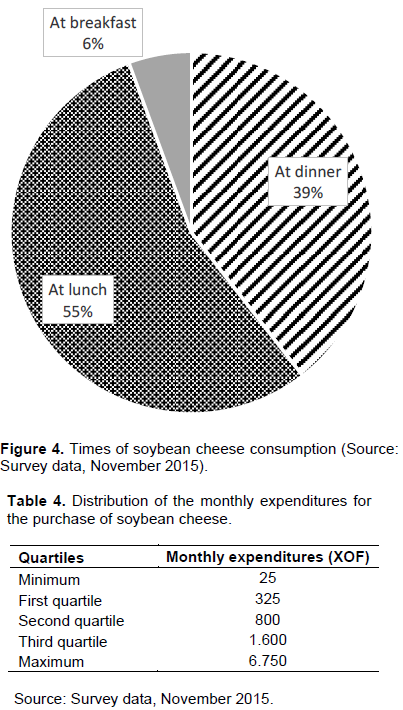
In most households, soybean cheese accounted for a low share of monthly expenditures on protein products (Figure 5). About two fifths of households interviewed used less than 5% of their protein purchase budgets for soybean cheese (Figure 5). More than one quarter of households spend 10 to 25% of their monthly expenditures on protein products for soybean cheese (Figure 6). For some of the households, the purchase of soybean cheese averaged more than 50% of monthly expenditures on protein products (Figure 5).
Consumers’ expectations
“Student’s t test of conformity showed that all nine attributes were important to consumers (the mean score of expectation was significantly higher than 4 for all attributes).” The comparison between perception and expectations scores showed that consumers of soybean cheese were satisfied for the following attributes; competitive price, good taste, easily available and attractive color (Table 5). There were gaps between perception and expectations for the other five attributes, that is, softness texture, tenderness, attractive presentation, hygienic processing conditions, and product conservability. Therefore, efforts are required from soybean cheese processors to meet consumers’ expectations. The most important discrepancies between perception and expectations were related to technical quality attributes (product conservability, softness texture, tenderness), and a functional quality attribute of the product (attractive presentation).
Profile of soybean cheese consumers
A variety of socio-demographic classes were consuming soybean cheese. The socio-demographic profile was diversified – with professions ranging from craftsmen to the liberal professions – among consumers interviewed. This socio-demographic diversity of consumers of soybean cheese offers significant market potential for the product. With further analysis, this diversity may allow one to consider market segmentation for deeper understanding of the expectations of different social classes.
Interest and consumption of soybean cheese
There was a gap between the percentages of households interested in soybean cheese and those who were consuming it. Giving reasons for this discrepancy, some consumers justified their reluctance to buy soybean cheese to be their dissatisfaction during the first consumption. Besides, soybean cheese was not yet distributed in supermarkets; which limits its access to the people who buy in these places. This discussion suggests a need for increased coordination in soybean cheese value chain, for the product to be readily available to all potential consumers in appropriate sales places.
Motivations for consumption of soybean cheese
Competitive price was the main motivation of consumption of soybean cheese, followed by nutrition, available protein, and pleasure. Former studies reported competitive price as an important concern for consumers.
This is the case for Quebec consumers of cow milk cheese (Group AGECO, 2006), and urban consumers of construction timber in southern Benin (Aoudji et al., 2011). This study supports the general idea that price plays a critical role in consumer behavior (Ryu and Han, 2010; Grunert et al., 2014). Regarding the seeking of a nutritious food, that is, nourishing/good for health, households consider that the consumption of soybean cheese would be beneficial for health. This product provides nutriments to adults and children (Ogunniyi et al., 2012). Soybean cheese being a vegetable product rich in protein, vitamins, and minerals, could be a new health-food. Besides, soybean fats, mostly unsaturated, contain essential fatty acids. Essential fatty acids are particularly involved in the structure of nerve cells (Roussel, 2005). These elements could be exploited by value chain stakeholders, for better promotion of the product.
Consumers’ expectations
Consumers were satisfied with four (40%) attributes, that is, competitive price, good taste, easily available, and attractive color. Therefore, the hypothesis of the satisfaction of soybean cheese consumers was not verified. Concerning competitive price, a previous study in the same region showed a dissatisfaction of consumers of timber for the price attribute (Aoudji et al., 2011).
Consumer satisfaction about this attribute for the soybean cheese could be related to the fact that this product is cheaper on the market than other protein products, such as cow milk cheese. The higher price of cow milk cheese could be supported by the fact that its production takes place in the North and Central Benin. Consequently, cow milk based cheese is scarcely accessible to households in the southern region of the country; hence their positive perception on the price of soybean cheese, which, like the cow milk based product, is rich in proteins (Endres, 2001; Michaud and Vodouhè, 2012; Nguyen et al., 2016).
Consumer satisfaction about the attributes of taste and color highlights the positive aspects of the processing technologies used by women processors. However, consumer dissatisfaction on other technical quality attributes such as tenderness shows the needs of strengthening technological capabilities.
Consumer dissatisfaction about the attribute "hygienic processing conditions" reflects a lack of confidence in the production conditions of soybean cheese. This was highlighted in a study on improved processing techniques of soybean cheese (Assongba et al., 2014). It was argued that promoting the hygienic quality of soybean cheese is one of the main challenges for consumer acceptability of the product in Benin.
Therefore, food technology laboratories could develop and disseminate to the processors the guidelines on the appropriate conditions to produce soybean cheese. Certification under a collective label could be a way to reassure consumers, but the implementation of this solution requires the organization of processors in the framework of collective action. This type of action is useful for market access and the inclusion of marginalized groups in lucrative value chains (Blandon et al., 2009; Hellin et al., 2009; Maertens et al., 2012).
According to consumers, soybean cheese kept for more than two days loses its organoleptic values; hence the dissatisfaction for the attribute "product conservability". This is due to the fact that majority of the consumers were buying fried soybean cheese, a form in which conservation is difficult. However, there are techniques for preserving raw soybean cheese. These techniques are either unknown or very expensive for majority of the consumers.
Raw soybean cheese can be kept in a refrigerator (HELVETAS-Benin, nd). Besides the cost of energy, only a few proportions of the Beninese households have a refrigerator. As techniques more affordable to consumers, raw soybean cheese can be kept after pasteurization in bottles for one month (ProAgri, 2012). Efforts are needed to develop more low-cost conservation techniques in order to popularize these techniques among consumers. Improving the conservability of soybean cheese could also be achieved through more efficient processing techniques.
Consumers found that the texture and level of tenderness of soybean cheese did not allow it to be well impregnated in sauces, contrary to cow milk based cheese, hence their dissatisfaction on these two attributes. Compared to cow milk based cheese, soybean cheese is harder. Texture and tenderness could also be affected by the processing technique, especially the ferment used by processors (ProAgri, 2012). Research is needed to develop improved soybean cheese processing technologies.
On the subject of product presentation, processors usually do not pack up the soybean cheese, hence the dissatisfaction of consumers for the attribute "attractive presentation". The presentation of a product plays a critical role in consumers' purchasing decisions (Silayoi and Speece, 2004; Kotler et al., 2008; Raheem et al., 2014). An attractive presentation of soybean cheese, through appropriate packaging, is essential for the promotion of this product and a better penetration on the market. This includes strengthening the capacities of processors on the satisfactory presentation of the product. This capacity building could be part of an action-research that will allow innovation development while evaluating its implementation.
The objective of this study was to analyze the consumption of soybean cheese among households in Abomey-Calavi (Department of the Atlantique, Southern Benin), in order to improve the value of this product.
Soybean cheese is consumed by a diversity of socio-demographic groups. As a high protein food, soybean cheese is a substitute for cow milk cheese. The motivations supporting the consumption of soybean cheese were; competitive price, nutritious food, source of protein easily available and pleasure. The evaluation of expectations revealed that consumers were not satisfied about the following attributes; softness texture, tenderness, attractive presentation, hygienic processing conditions and "product conservability". Potential market can be an added advantage if only the stakeholders of the soybean cheese value chain make the required efforts to meet the consumers’ expectations.
Research is needed to develop more efficient soybean cheese processing technologies. That way, weaknesses in technical quality attributes such as tenderness and "product conservability" can be addressed. This paper highlighted the need to support women who are producing soybean cheese. This support includes training on proven production techniques of soybean cheese. Besides, support for collective action among processors is an important policy matter.
This will facilitate the setting up of a collective label for the production and marketing of soybean cheese. The leader in the implementation of these various actions is the primary responsibility of the government and its departments in their strategies for poverty alleviation, the pro-poor growth, and women empowerment. NGOs and other facilitators of agricultural development could also contribute.
The authors have not declared any conflict of interests.
REFERENCES
|
Amos G, Steven F, Maryben C, Godwill N, Kwadwo O (2014). Collective action to improve market access for smallholder producers of agroforestry product: key lessons learned with insights from Cameroon's experience. Curr. Opin. Environ. Sustain. 6:68-72.
Crossref
|
|
|
|
Aoudji AKN, Adégbidi A, Ganglo JC, Agbo V, Yêvidé ASI, De Cannière C, Lebailly P (2011). Satisfaction across urban consumers of smallholder-produced teak (Tectona grandis L.f.) poles in South Benin. For. Policy. Econ. 13:642-651.
Crossref
|
|
|
|
Assongba CM, Akpo F, Boko F, Ahouangnatoh B (2014). Technique de transformation de soja en fromage amélioré par l'épluchage du soja et l'incorporation de lait de pâte de niébé. After Congress. View
|
|
|
|
Becker T, Benner E, Glisch K (2000). Consumer perception of fresh meat quality in Germany. Br. Food. J. 102(3):246-266.
Crossref
|
|
|
|
Blandon J, Henson S, Cranfield J (2009). Small-scale farmer participation in new agri-food supply chains: Case of the supermarket supply chain for fruit and vegetables in Honduras. Int. J. Dev. 21(7):971-984.
Crossref
|
|
|
|
Broutin C, Hermelin B, Levard L (2014). Comment améliorer l'accès au marché pour les exploitations familiales ? Coll. Etudes et travaux en ligne n°41, Editions du Gret.
|
|
|
|
Close AG, Kukar-Kinney M (2010). Beyond buying: Motivations behind consumers' online shopping cart use. J. Bus. Res. 63(9-10):986-992.
Crossref
|
|
|
|
Dedjelenou B (2014). Essor de la filière soja dans le Sud-Bénin.
View
|
|
|
|
Duffer J, Moulins JL (1989). La relation entre la satisfaction du consommateur et sa fidélité à la marque. RAM 4(2):89.
|
|
|
|
Endres JG (2001). Soy Protein Products Characteristics, Nutritional Aspects, and Utilization. Revised and Expanded Edition. AOCS Press, Champaign, Illinois.
Crossref
|
|
|
|
Fischer E, Qaim M (2012). Linking smallholders to market: Determinants and impacts of farmer collective action in Kenya. Word Dev 40:1255-1268.
Crossref
|
|
|
|
Fold N, Gough KV (2008). From smallholders to transnationals: the impact of changing consumer preferences in the EU on Ghana's pineapple sector. Geoforum 39:1687-1697.
Crossref
|
|
|
|
Glitsch K (2000). Consumer perceptions of fresh meat quality, cross-national comparison. Br. Food J. 102(3):177-194.
Crossref
|
|
|
|
Group AGECO (2006). Étude de la demande québécoise en fromages fins: Rapport Final.
View
|
|
|
|
Grunert KG, Hieke S, Wills J (2014). Sustainability labels on food products: Consumer motivation, understanding and use. Food Policy. 44: 77-189.
Crossref
|
|
|
|
Hellin J, Lundy M, Meijer M (2009). Farmer organization, collective action and market access in Meso-America. Food Policy. 34(1):16-22.
Crossref
|
|
|
|
HELVETAS-Bénin (nd). Guide du formateur dans la transformation du soja en fromage.
|
|
|
|
Jayne TS, Anriquez G, Collier E (2013). African agriculture toward 2030: changes in urbanization and agricultural land dynamics and their implications for CGIAR research A Foresight Study of the Independent Science and Partnership Council. Paper prepared for the ISPC Foresight meeting, January 24-25, 2013, Boston, MA.
View
|
|
|
|
Kelley SW, Turley LW (2001). Consumer perception of service quality attributes at sporting events. J. Bus Res. 54:161-166.
Crossref
|
|
|
|
Kilchling P, Hansmann R, Seeland K (2009). Demand for non-timber forest products: Surveys of urban consumers and sellers in Switzerland. For. Policy. Econ. 11 (4):294-300.
Crossref
|
|
|
|
Kotler P, Armstrong G, Wong W, Saunders J (2008). Principles of Marketing. London: Prentice Hall.
|
|
|
|
Le Courtois E, Gálvez-Nogales E, Santacoloma P, Tartana F (2011). Enhancing farmers' access to markets for certified products: A comparative analysis using a business model approach. Agricultural management, marketing and finance. Working document. Food and Agriculture Organization of the United Nations, Rome.
View
|
|
|
|
Lewis GH, Johnson RG (1971). Kendall's coefficient of concordance for sociometric rankings with self-excluded. Sociometry. 34(4):496-503.
Crossref
|
|
|
|
Maertens M, Minten B, Swinnen J (2012). Modern Food Supply Chains and Development: Evidence from Horticulture Export Sectors in Sub-Saharan Africa. Dev. Policy Rev. 30(4):473-497.
Crossref
|
|
|
|
Michaud A, Vodouhè GT (2012). L'émergence des innovations au Bénin : cas du soja et de ses produits dérivés de grande consommation. Rapport d'étude, JOLISAA.
|
|
|
|
Nguyen L, Streinberg F, Zidenberg-Cherr S (2016). Nutrition and Health Info Sheet: Soy. For Health Professionals. Center for Nutrition in Schools, Department of Nutrition, University of California, Davis.
View
|
|
|
|
Ogunniyi LT, Ajao AO, Adepoju AA (2012). Economic Efficiency of Soybean Production in Ogo-Oluwa Local Government Area of Oyo State, Nigeria. Am. J. Exp. Agric. 2(4):667-679.
Crossref
|
|
|
|
Oliver RL (1980). A cognitive model of the antecedents and consequences of satisfaction decisions. J. Mark. Res. 17:460-469.
Crossref
|
|
|
|
ProAgri (2012). Contribution à l'élaboration de la stratégie nationale pour le développement de la chaîne de valeur soja et autres légumineuses : Etat des lieux dans les départements Atacora-Donga, Borgou-Alibori et Collines et éléments clés de stratégie pour le développement de la filière soja au Bénin. Rapport d'étude.
|
|
|
|
Ragaert P, Verbeke W, Devlieghere F, Debevere J (2004). Consumer perception and choice of minimally processed vegetables and packaged fruits. Food. Qual. Prefer. 15(3):259-270.
Crossref
|
|
|
|
Raheem AR, Vishnu P, Ahmed AM (2014). Impact of product packaging on consumer's buying behavior. Eur. J. Sci. Res. 122(2):125-134.
|
|
|
|
Roussel M (2005). Les miracles du soja. De l'aliment au complément alimentaire, découvrez les multiples vertus du soja pour : prévenir cancer et maladies cardiovasculaires et diminuer les troubles de la ménopause.
View
|
|
|
|
Ryu K, Han H (2010). Influence of the Quality of Food, Service, and Physical Environment on Customer Satisfaction and Behavioral Intention in Quick-Casual Restaurants: Moderating Role of Perceived Price. Int. J. Hosp. Tour. Res. 34(3):310-329.
Crossref
|
|
|
|
Santosa M, Guinard JX (2011). Means-end chains analysis of extra virgin olive oil purchase and consumption behavior. Food. Qual. Prefer. 22(3):304-316.
Crossref
|
|
|
|
Shiferaw B, Hellin J, Muricho G (2011). Improving market access and agricultural productivity growth in Africa: What role for producer organizations and collective action institutions? Food Sec. 3:475-489.
Crossref
|
|
|
|
Silayoi P, Speece M (2004). Packaging and purchase decisions: An exploratory study on the impact of involvement level and time pressure. Br. Food J. 106(8):607-628.
Crossref
|
|
|
|
Taylor KA (1997). A regret theory approach to assessing consumer satisfaction. Mark. Lett. 8(2):229-238.
Crossref
|
|
|
|
Verbeke W, Vackier I (2004). Profile and effects of consumer involvement in fresh meat. Meat Sci. 67:159-168.
Crossref
|
|
|
|
Vorley B, Lançon F (2016). Urban Food consumption, urbanisation and rural transformation: The trade dimensions. IIED, London.
View
|
|
|
|
Yumkella KK, Kormawa PM, Roepstorff TM, Hawkins AM (2011). L'agribusness au secours de la prospérité de l'Afrique. ONUDI.
|
